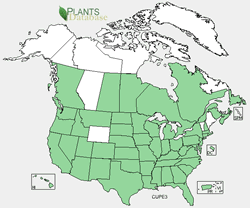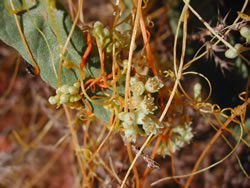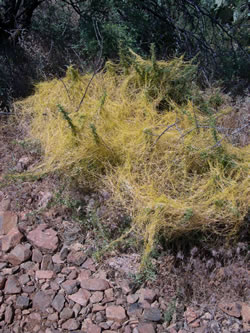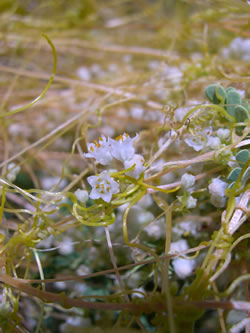Plant of the Week
 Cuscuta pentagona range map. USDA PLANTS Database.
Cuscuta pentagona range map. USDA PLANTS Database.
 Orange twining stems of Cuscuta pentagona with white flowers drap over a leaf, from Sedona, Arizona. Photo © Max Lichert.
Orange twining stems of Cuscuta pentagona with white flowers drap over a leaf, from Sedona, Arizona. Photo © Max Lichert.
 Cuscuta spp., from lower slope of Mingus Mountain, edge of Verde Valley, Yavapai County, Arizona. Photo © Max Lichert.
Cuscuta spp., from lower slope of Mingus Mountain, edge of Verde Valley, Yavapai County, Arizona. Photo © Max Lichert.
 Close-up of the flower of Cuscuta spp., from lower slope of Mingus Mountain, edge of Verde Valley, Yavapai County, Arizona. Photo © Max Lichert.
Close-up of the flower of Cuscuta spp., from lower slope of Mingus Mountain, edge of Verde Valley, Yavapai County, Arizona. Photo © Max Lichert.
Five-angled Dodder (Cuscuta pentagona)
By Walter Fertig
Dodders (genus Cuscuta) are among the simplest of plants in their gross appearance. At maturity, they consist only of thread-like yellow or orange stems, white flowers, and small round fruits. The mature dodder has no roots or leaves. It is a parasite and is completely dependent on a host plant for its nutrition and water uptake.
Taxonomists recognize between 100 and 150 species of dodder worldwide, with nearly two-thirds native to the New World (especially the tropics). Identification of dodders is difficult to nearly impossible without flowers or fruits. The flowers are generally small with white, almost translucent petals fused into a bowl-like corolla. Five stamens are fused to the inner wall of the corolla and are often associated with a ring of fringed hairs or scales. The fruits are ball-like capsules topped by a pair of straight or round antennae-like stigmas. Dodder flowers and fruits share many similarities with morning glories (Convolvulaceae family), though traditionally dodders are placed in their own family, the Cuscutaceae.
Dodder seeds germinate on the ground but quickly send up a stem that begins searching for a host plant to parasitize. Researchers have discovered that the young dodder is attracted to a host based on odor or by the amount of light reflected off the host plant’s leaves. The dodder does not produce roots and must reach a host quickly before using up the reserve of nutrients in its seed. Only seeds that germinate close to a host plant will survive.
Assuming contact is made, the dodder produces two types of specialized stems called haustoria that will penetrate the host’s own stem. One form of haustorium will tap into the host’s water conducting xylem, while the other type will surround the food-carrying phloem. Dodders may parasitize a single species or several different types of hosts. Several species are considered agricultural pests, especially those that specialize on tomatoes, alfalfa, and pumpkins. In addition to sapping their victims of their own food and water, dodders can also transmit destructive plant viruses.
Five-angled dodder (Cuscuta pentagona) is one of approximately 50 native and introduced dodder species found in North America. It ranges over much of the continent and occurs in all but four states (Alaska, Wyoming, Maine, and Vermont). This species has also been accidentally introduced in agricultural settings across the world where it is becoming a serious pest. Five-angled dodder parasitizes a wide range of herbaceous plant species, rather than specializing on a few hosts like most dodders.

